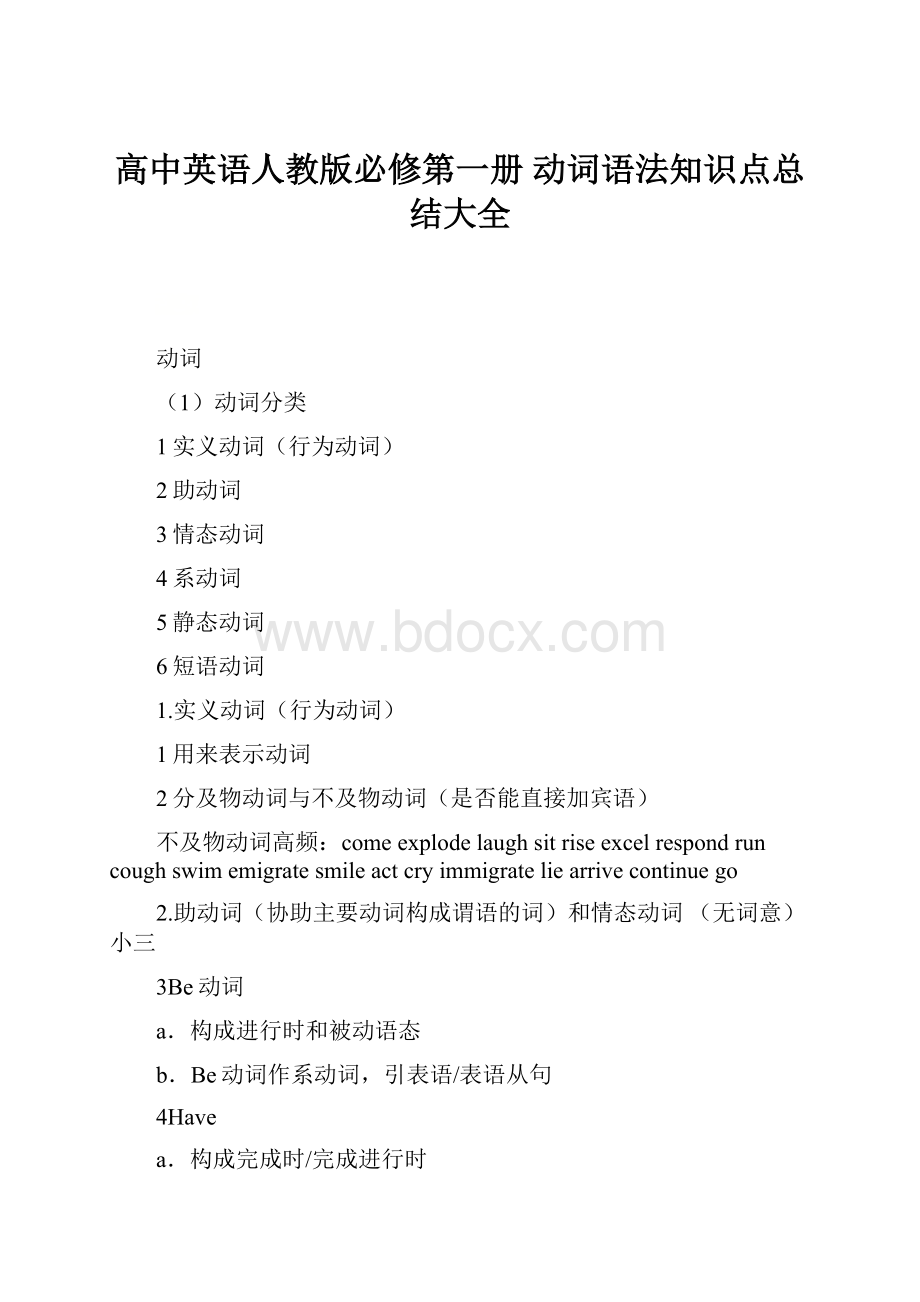高中英语人教版必修第一册 动词语法知识点总结大全.docx
《高中英语人教版必修第一册 动词语法知识点总结大全.docx》由会员分享,可在线阅读,更多相关《高中英语人教版必修第一册 动词语法知识点总结大全.docx(13页珍藏版)》请在冰豆网上搜索。

高中英语人教版必修第一册动词语法知识点总结大全
动词
(1)动词分类
1实义动词(行为动词)
2助动词
3情态动词
4系动词
5静态动词
6短语动词
1.实义动词(行为动词)
1用来表示动词
2分及物动词与不及物动词(是否能直接加宾语)
不及物动词高频:
comeexplodelaughsitriseexcelrespondruncoughswimemigratesmileactcryimmigrateliearrivecontinuego
2.助动词(协助主要动词构成谓语的词)和情态动词(无词意)小三
3Be动词
a.构成进行时和被动语态
b.Be动词作系动词,引表语/表语从句
4Have
a.构成完成时/完成进行时
b.实义动词:
have有意义等同eat/drink
5Do
a.构成疑问句/否定句/强调句
b.实义动词:
做
3.情态动词+动词原形(有词意)妾
①can/could
②may/might
③must
④should/shall/oughtto
⑤would/will
4.静态动词
①表思想
Believe,doubt,know,understand
②表拥有
Have,own,want,contain
③表感觉
Hear,see,smell
④表情感
Love,hate,want,need
5.动词短语
构成:
动词+介词或动词+副词(通常与原动词含义不同)
(二)动词的形式
1.动词原形
2.第三人称单数
①一般现在时中
②主语为第三人称单数,谓语动词要用第三人称单数形式
A.直接动词词尾加s
B.以字母s,x,ch,sh或o结尾的动词加es
C.辅音加y,变y为i加es
D.不规则变化
3.动名词与现在分词
6直接词尾加ing
7词尾去掉e,去掉e加ing
8ie结尾的,变ie为y加ing
9辅音+元音+辅音,双写词尾加ing
4.动词过去式与过去分词
A.规则动词的过去式加ed
B.以e结尾的动词词尾直接加d
C.不规则变化
5.动词时态
5.1一般现在时
形式:
①肯定形式:
第三人称单数用三单,其他用动词原形
②否定形式:
主语+do/doesnot+谓语动词原形
③疑问形式:
疑问词+do/does+主语+谓语动词原形
用法:
①现在时段发生的动作:
Ifeelgreat!
②习惯性动作/常发生的动作
③表示客观真理
④用于电影,赛事,时间的评论,独白,报道等
⑤谈论时间表,日程表
eg:
Thetrainleavesathalfpastfour.
⑥一般现在时表将来
当主句为将来时或表将来意义时,时间和条件的状语从句必须用一般现在时表将来。
(主讲从现)
5.2一般过去式
形式:
①肯定形式:
主语+动词过去式
②否定形式:
主语+didnot+谓语动词原形
③疑问形式:
疑问词+did+主语+动词原形
用法:
表过去发生的动作
5.3一般将来时
形式:
①肯定形式:
主语+will/begoingto/beto/beaboutto+原形
②否定形式:
主语+willnot(won’t)+谓语动词原形
③疑问形式:
疑问词+will+主语+动词原形
用来:
表还没发生,未来将要发生的行为,动作,事件
5.4现在进行时
形式:
①肯定形式:
主语+be+动词ing
②否定形式:
主语+be动+not+动词ing
③疑问形式:
疑问词+be动词+主语+动词ing
用法:
①说话的时刻正在发生的动作
②常与always,constantly,continually,forever,repeatedly,never等词连用含有抱怨语气。
表总是。
③表将来,多用于已经安排好的事情。
Iamleaving。
④begoingto
<1>计划,安排的动作
<2>确定将会发生的事情
注意:
有些动词不能用于现在进行时
a.情感类:
love,hate,prefer
b.所属类:
have,own,want,belong
c.感官类:
see,hear,smell,seem
d.思想类:
know,believe,remember
e.测量类:
contain,consist,fit
5.5现在完成时
形式:
①肯定形式:
主语+have/has+过去分词
②否定形式:
主语+haven’t(havenot)/hasn’t(hasnot)+过去分词
③疑问形式:
疑问词+have/has+过去分词
用法:
①表过去完成的动作
这个动作对现在造成影响或现在有关
常与still,yet,already,always连用
②讨论个人的经历
③过去已经开始的动作一直延续到现在
甚至有可能继续延续下去
常与before,since,for,already,manytimes,sofar,yet连用
5.6过去完成时
形式:
①肯定形式:
主语+had+过去分词
②否定形式:
主语+hadn’t(hadnot)+过去分词
③疑问形式:
疑问词+had+主语+过去分词
用法:
①表过去的某个动作之前发生的动作。
Shesaidshehadwrittenthreelettersthedaybefore.
Ididn’tsayanythinguntilshehadfinishedtalking.
②与after,assoonas,themomentthat,until
③与before,when,bythetime连用
6.被动语态
定义:
①主语是动作的执行者(即某人做某事),叫主动语态。
②主语是动作的承受着(即某事被做)叫被动语态。
步骤:
①将主动语态的宾语改为被动语态的主语
②将主动语态的谓语动词改为‘bedone’
③将主动语态的主词改为介词by之后的宾语,放在谓语动词之后(有时可省略)
非谓语动词
不充当谓语的动词
1.动名词
形式:
①动名词与现在分词同型(v-ing)
②起到名词的作用
作用:
①作主语谓语动词为单数
Eg:
ReadinghelpsyoulearnEnglish.
②作宾语
有的动词直接加动名词作其宾语;有的加介词后动名词作其宾语
Eg:
<1>Hequitsmokinayearago.
<2>Ilookforwardtohelpingyoupanitthehouse.
③It+形容词+动名词
Eg:
Itisnousetellinghimnottoworry.
此类形容词还包括:
better、wonderful、enjoyable、interesting、foolish、difficult、useless、senseless、worthwhile
④作表语:
对主语进一步说明,相当于一个名词。
Eg:
<1>Myjobisteaching.
<2>Seeingisbelieving.
⑤作定语:
表示用途或性质
Eg:
<1>aswimmingpool=apoolforswimming
<2>amovingtruck=atruckformoving.
以下动词及句型后常跟动名词作宾语
Beusedto/getusedto
Can’thelp/giveup
Can’tstand/goon
Endup/havedifficulty
Feellike/haveproblems
Finish/havetrouble
2.分词
形式:
①现在分词的形式同动名词一样,在动词后面加ing
②过去分词的形式则在动词后面加ed
(1)现在分词
1)一般式:
表示的动作与主语动作同时发生
Eg:
Tomcamesaunteringupthepath.Reachingfortheflower,Ilostmybalance.
Notbeingabletowinthegame,Ilostmyconfidence.
2)完成式:
表示该动作发生在谓语动词之前且已经完成
Eg:
Havingheardthenews,hequicklysoldhisbrother’srecordcollection.
Havingrestedforawhile,wecontinuedourjournry.
Nothavingfinishedhiswork,hecouldnotleavetheoffice.
作用:
①作定语:
作前置/后置定语;相当于定语从句
Eg:
<1>Themancarringthebricks(=whoiscarringthebricks)ismyfather.
<2>Thereissomeoneknockingatthedoor.(someonewhoisknocking)
②作表语:
相当于一个形容词,表示主语的特征
Eg:
<1>Thenewsisencouraging.
<2>Thepresentsituationisterrifying.
<3>Myjobisreallytiring.Idon’tgethomeuntil10p.m.sometimes.
③作状语:
表谓语动词发生的时间、方式、伴随、让步等,相当于状语从句;逻辑主语就是句子的主语。
Eg:
原因状语<1>Hewastalkingtoherfriendandforgoteverythingaroundher.=Talkingtoherfriendsheforgoteverythingaroundher.
<2>Sincewewatchthenewseverydayweknowwhat’sgoingonintheworld.=Watchingthenewseverydayweknowwhat’sgoingonintheworld.
伴随状语<3>Thedogwaggeditstailandbitthepostman.=Waggingitstailthedogbitthepostman.
<4>Themanwassittinginthecafé.Hewasreadingapaper.=Themanwassittinginthecaféreadingapaper.
时间状语<5>Whileshewastidyingupherroomshefoundsomeoldphotos.=Tidyingupherroomshefoundsomeoldphotos.
条件状语<6>Iftheydonothaveenoughmoneytheywillspendtheirholidaysathomelastyear.=Nothavingenoughmoneythey
willspendtheirholidaysathomenextyear.
结果状语<7>Carbonburnsinoxygenorair,therebyformscarbondioxide=Carbonburnsinoxygenorair,therebyformingcarbondioxide.
(2)过去分词
作用:
1)作表语:
表示谓语动词所处的状态。
Eg:
Iwasalarmedbytheloudbang.
Hewasamusedtohearhislittlesonsinginginthebath.
2)作定语:
①前置/后置定语
②相当于一个定语从句,其逻辑主语构成被动关系。
Eg:
Aburntchild(=achildwhoisburnt)dreadsfire.
Themusiciansstoodup,surroundedbythunderousapplause,(=whoissurroundedbythunderousapplause.)
3)作状语:
①表示谓语动词发生的时间、方式、伴随、让步等。
②相当于一个状语从句
③过去分词作状语时的逻辑主语就是句子的主语
Eg:
原因状语<1>Batteredbythewind.Johnfelltohisknees.=Becausehewasbatteredbythewind,Johnfelltohisknees.
<2>Deceivedbyhisfriends,hecommittedsuicide.=Sincehewasdeceivedbyhisfriends,hecommittedsuicide.
时间状语<3>Seenfromthehill,thetownlooksmagnificent=Whenitisseenfromhill,thetownlooksmagnificent.
条件状语<4>Givenanotherchance,Iwilldobetter.
让步状语<5>Exhaustedbytheworking,theywentonstudyingatnight.
(3)动词不定式
形式:
肯定式:
to+
否定式:
notto+动词原形
作用:
1)作主语
Eg:
①Tolearnisveryimportant.
②Todriveintherightisnotallowedhere.
③Togotocollegeisagoodidea.
注意:
①不定式作主语时,可置句首。
②如果过长,可采用it作形式主语,不定式后置的结构。
※重点句式:
1.Itis/was+adj./n.+todo(做什么。
。
是。
。
)
Eg:
①Itwasdifficulttoanswerthequestion.
②It’sabighousetoclean.
2.Itis/was+adj.+forsth./sb.+todo.
Itis/was+adj.+ofsb.todo
Eg:
①Itisnecessaryforthisdoortobelocked.
②Itisverykindofyoutohelpme.
2)作表语
Eg:
Themostimportantthingisnottogiveup.
3)作宾语
Eg:
①Iwanttoswiminthepool.
②Theyintendtopostponethetrip.
③Agoodtranslatorishardtofind.
4)作定语
①Givehimanornamenttopolish.
②Ineedavolunteertotakethemiuntes.
5)作状语